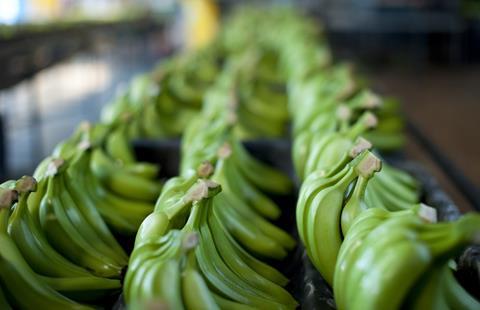
Opinions differ across the category as to how conditions are at present for those trading in the British banana market.
The data doesn’t make for particularly pleasing reading, though. The market has shrunk by 3.6 per cent, or £21.1 million, in value terms over the past year, according to data from Kantar Worldpanel, while volume sales have slumped by 0.8 per cent, a decrease of 5,900 tonnes, the grocery market analyst reports.
Simon Trewin, group commercial director at banana giant SH Pratt, says: “Recently, we’ve seen steady volumes, with no great changes over previous months, or last year. Prices have remained stable, both cost and retail, and the category remains very competitive for both suppliers and retailers alike.”
On the other hand, Stephen Fox, managing director at foodservice and wholesale banana importer and supplier JN Fox & Sons, is more cautious about the situation, and thinks that change may not be afoot until after the Christmas decorations have come down.
He tells FPJ: “The last quarter has seen a worldwide oversupply of bananas. In recent weeks, this has filtered into the UK, resulting in a poor end to 2015, with a suggestion that the market will not improve until 2016.”
The impact on the product from inclement weather is a key issue, as always. While the UK has recently experienced storms Abigail, Barney and Clodagh, the Americas have had to contend with the latest incarnation of El Niño.
Trewin expects El Niño to result in a possible knock-on effect on availability and prices, although he notes that hurricanes so far this year have missed key production areas. “Touch wood,” he adds, knowing that this has the potential to change and give the category a jolt at any moment.
Fox notes: “The El Niño effect is a discussion point, as this year is among the strongest on record, and is expected to significantly influence weather and climatic patterns.
“With particular reference to Ecuador, we have already seen visible signs of this starting, and there are varying predictions on how this will affect production, which could have an overall impact on the overall supply of bananas.”
However, Juan Carlos Yepez, trade officer with the Ecuadorean government trade body Pro Ecuador, says: “Risk control and precautions are being put in place to prevent affectation of crops due to possible bad weather caused by El Niño. So far, El Niño forecast and predictions are fluctuating, but most experts now agree, it’s not going to be as negative as first thought.”
Luckily for those in the trade, Hurricane Patricia failed to cause as much damage as had been forecast when it tore across Mexico, although heavy rain earlier on in the season in Costa Rica did cause some setbacks on the supply front.
Scientists at Wageningen University & Research Centre in the Netherlands have demonstrated that the same clone of the Fusarium fungus is infecting Cavendish bananas in several countries across the world. The study, which forms part of research conducted in co-operation with Australia’s University of Queensland and Diversity Arrays Technology, and the University of Florida in the US, shows that this Fusarium clone – also known as Tropical Race 4 – is continuing to spread irrespective of quarantine measures, with “disastrous” results for growers.
Trewin tells FPJ that the cases of Panama Disease and Black Sigatoka Disease, “which could be potentially very difficult for the Cavendish variety”, means that finding hybrids or alternative varieties should be a “prime focus” for the industry going forward.
With such a strong purchase penetration rate in not just the UK, but worldwide, a coherent back-up plan will need to be formulated as soon as is possible.
Despite Kantar data showing a drop in the number of bananas shoppers in the UK buying per shopping trip, Trewin says: “The demand for bananas remains strong, with it being one of the most popular fruits to buy. However, there is little opportunity to add value or enhance the offer, over and above what is currently available. The commoditised nature of the banana category does not allow much room in cost prices for promotions either.”
Yepez expects to see the volume of Ecuador’s bananas exported to the UK rising in 2016, and adds that plantain exports to the UK are also growing. However, he stresses the need for change on pricing: “Hopefully, prices will increase in the UK,” Yepez says. “Consumers need to pay the real value of a fruit that comes from different parts of the world, and is only 68p per kilo.”



